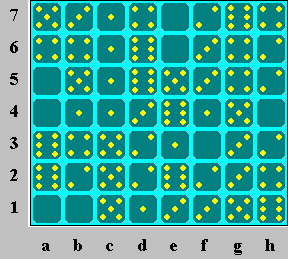
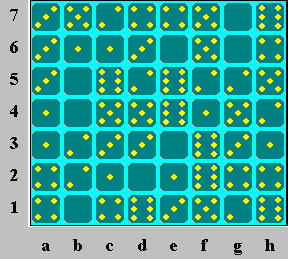
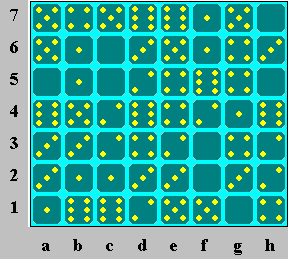
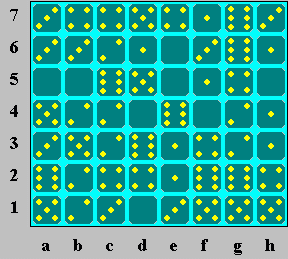
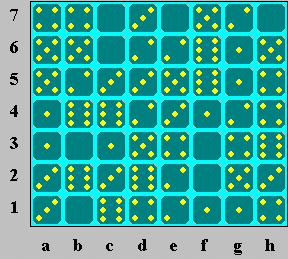

In 1874, O.S. Adler developed a domino game with a double-7 set
(36 pieces), which he patented in 1893 in Germany as Dominosa
(under the pseudonym Richard Osa). He wrote a book on it in
1894, and later collaborated on another book with the noted game
collector and writer Fritz Jahn. I have looked at both the
patent application and the book (see
Bibliography); the 1921 edition is available on archive.org.
It's not clear to me, with my very limited German, what the patent is
for,
or whether a deductive puzzle was the main intent (most of the diagrams
show constructions similar to quadrilles), although the book does have
one 9x8 rectangle and a solution. Nevertheless, the
name Dominosa has been adopted by some sources as the name for the puzzle.
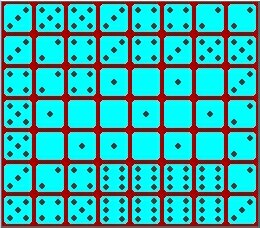
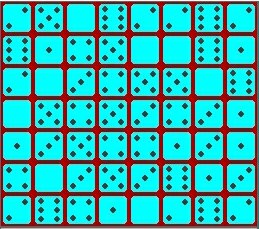
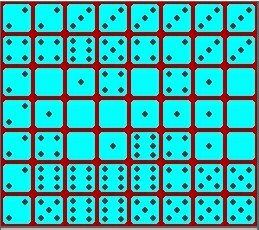
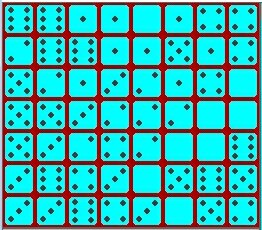
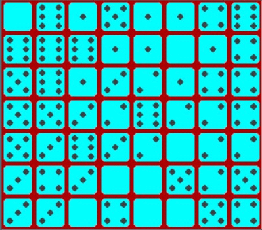
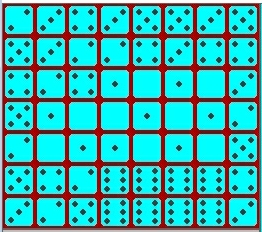
Dissected Dominoes -- Solving domino logic puzzles
The grids have been labeled to help make the solutions easier to follow.





Problem 1: There are only
two possible places to put the 5-5
domino; both use the 5 at c2, so it cannot be part of a 2-5. The
only other place
for the 2-5 is at cd3, so the 5-5 must be at c12. The
only place left
for the 2-2 is at h56, forcing the 4-6 to be at gh7, and the 6 at h1
must be part of 5-6
to avoid duplicating 4-6. If the 0-6 were at a12, there would be
no way to pair the
6 at a3 without duplicating either 0-6 or 4-6, so the 0 at a1 must be
part of 0-0. If the 0-3 domino were at ef6, 0-2 would have
to be at ef7,
forcing the 0 at h4 to be part of 0-5 (to avoid duplicating 0-2), and
the 0 at a5 to be
part of 0-4 (to avoid duplicating 0-0 or 0-5). But then 3-5 would
have to be at ab7,
and there would be no way to pair the 5 at e5 without duplicating 3-5
or 5-6. So 0-3
can only be at fg3. The only place left for 0-1 is ab4, and the
square at ab12 must
be divided into 2-4 and 6-6 to avoid duplicating 4-6. The
only place left for
0-6 is at de6, and the 5 at e5 must be part of 3-5, forcing 4-5 to be
at a67 and leaving
g56 as the only place for 4-4. 2-3, 0-4, and 0-5 are
forced, leaving h34 as the only place
for 0-2, and forcing 1-5 and 3-4. Now there is only one place for
3-3, and 1-2, 2-6,
and 1-6 are forced. 3-6 must be at d45, forcing 1-1, 1-3, and
1-4.
Problem 2: Avoiding duplications
If the 5-5 domino were at f67, it would leave bc4 as the only possible place for 0-5, and then g67 as the only possible place for 0-0. 4-6 would have to be at h67, and 0-4 and 4-4 would use the fours at a1 and e7 in either order. Then the fours at c1 and h2 would both need to be part of 1-4 to avoid duplicating other dominoes, so either 1-4 or some other domino would be duplicated. So it is impossible for 5-5 to be at f67, and it can only be at cd4. Now if 0-5 were at fg7, then the only place left for 4-5 would have to be h56, and the six at h7 would be isolated. So 0-5 must use the five at f6, 4-5 must be at ef7, 2-5 must use the five at h5, and the only place for 5-6 is at f12. 0-5 cannot be at fg6 (forcing 0-6 at gh7 and a duplicate 4-5 at h56), so it is at ef6.
Parity
The only location left for 6-6 is e45, and if the blank
at e3 were part of 0-1 or 0-3, it would divide the unused area into two
parts, each with
an odd number of squares. Those regions could not be divided into
a whole number of
dominoes (which must add up to an even number of squares), so the
arrangement is
impossible. This principle is called parity --
every unused region
must contain an even number of squares. So 0-6 must be at
ef3 (dividing into
two even regions), and 0-0 at g67 (avoiding duplication), which forces
4-6 at h67.
Now 2-6 must be at gh12 to avoid duplicating 4-6, and the
six at c5 can only
be part of 1-6, which forces 2-3 and 2-4. 3-6 must be at de1,
forcing 0-1 and 3-3.
Since 3-3 has been placed, the threes in column a must form 3-5,
1-3, and 0-3.
1-1 and 0-2 can only be at a34 and b34, and the two at b2
must be part of
1-2, forcing 0-4 and 4-4. 2-2 must be at fg5, and the remaining
dominoes are easy to
place.
Problem 3: If the 6-6 domino
were at de7, the six at b1 would have
to be part of 6-1, and 6-2 would be at cd1 to avoid duplication.
But then the six at
d4 would have to be part of 6-4, and the six at f5 would duplicate one
of the three
dominoes already placed. So 6-6 is at bc1, 3-1 is at a12,
and 1-1 is at bc2 to
avoid duplicating 3-1. 5-5 cannot be at ef1, because 3-2 at d12
and 3-0 at ef2 would
force 4-3 at g23 and a duplication with the three at h6. So 5-5
is at a67, and f1
must be part of 5-0, so 3-0 is at h67. 1-0 cannot be at bc6,
because 5-4 at bc7
would force 5-1 and fg7, and the one at b5 would duplicate 1-0 or
5-1. So the one at
b6 must form 4-1 at b67. 6-5 must be at cd7 (we already know 5-0
is at f12 or fg1),
forcing 6-1 at ef7 and 5-4 at g67. 0-0 must be at c56 to avoid
duplicating 3-0, and ab5 is
the only location left for 1-0. Other dominoes must be
placed to avoid
duplication: 6-3 at a34, 5-1 at ef6 (forcing 3-2 at d56), 5-3 at b34,
and 5-2 at de1. The
only remaining location for 4-4 is e45, and 2-1 can only be at fg4,
forcing 6-4 and 6-0.
6-2 must be at cd4 to avoid duplication, forcing 4-2, 3-3, and 2-0. 2-2
can only be at
h23, and the last three dominoes (4-0, 5-0, and 4-3) follow.
Problem 4: 6-3
cannot be at a23, since 5-2 would then be at ab1, and
duplicated
with the 5 at b3. Therefore either the 6 at g7 or the 6 at g6 must be
part of 6-3, and 6-6
must be at fg2. The only places for 5-1 are d56 and d67, and
either the 1 at h3 or
the 1 at h4 must be part of 2-1, so 1-1 must be at e23. 5-3 must be at
a34 or ab3 (since
6-3 is not at a23), so 3-0 must be at de1. This forces 5-5 at fg1 and
5-4 at h12, so 5-1
must be at d67 to avoid duplicating 5-4. 2-1 is not at gh4 (otherwise
it would force a
duplicate 2-1 at gh3), so it is at gh3, and 1-0 is at h45. This forces
4-0 at f34 and 4-2
at g45, and 4-1 must be at ef7 to avoid duplicating 4-0. Since 6-6 is
already placed, 6-3
must be at gh7 and 6-1 at gh6. Since 3-0 is already placed, 3-1 must be
at f56, forcing
0-0 at e56, 6-0 at de4, and 6-5 at cd5. 0-0 and 3-0 are already placed,
so 5-0 is at a45
and 2-0 at b45, forcing 2-2 at c34 and 6-4 at d23. The only place
for 5-3 is ab3,
and the only place left for 4-4 is bc7, forcing 3-3 and 3-2 in the
upper area, and 4-3,
6-2, and 5-2 in the lower area.
Problem 5: 5-4 cannot be a67, since there would be no way to place the 5-5, so 4-4 is at ab7. 0-0 must be at c67, since 4-0 must use the zero at f3.
Making an assumption
What happens if 2-2 is at e12? The four at d1 would have to be part of 6-4, and 4-2 would be at gh4, since 4-4 and 6-4 are elsewhere. 4-0 could not be at fg3, since the region blocked off in the lower right would consist of seven squares and could not be covered. 4-0 would have to be at ef3, and 6-3 at h23 (since 6-4 would be at cd1 or d12). 6-3 would force 4-1 at gh1 and 5-4 at g23, which would make it impossible to use the four at h5 without duplicating either 5-4 or 4-1. So 2-2 is not at e12, but at de6. Making assumptions about possible placements and checking the consequences is usually necessary in solving harder domino puzzles; sometimes you must go quite far along before finding a contradiction.
Since 2-2 is at de6, 3-0 is at de7, and 3-3 is at a12 to avoid duplication. 6-3 cannot be at c45, since 3-1 would have to be at c23 and 6-4 at either gh3 or h34 to avoid duplicating 6-3. But then 6-0 would have to be at bc1 to avoid duplicating 6-4, and once again an area of odd size (nine squares) would be walled off on the left side. Since 3-3 is already placed, the three at c5 must be part of 3-2 at bc5, forcing in turn 5-5 at ab6, 5-1 at a45, 1-0 at ab3, and 6-6 at bc3. Since 5-1 has been placed, 3-1 is at c23, forcing 6-0 at b12 and 6-4 at cd1. The only place left for 6-3 is h23, forcing 4-1 at gh1. With 4-4 and 4-1 placed, 4-2 must be at gh4 and 5-4 at h56. This forces 2-0 at gh7, 6-5 at f67, and 1-1 at g56. Since 5-4 has been placed, 4-0 must be at fg3 and 5-0 at fg2, forcing 2-1 at ef1. 3-2 has already been placed, so 5-2 is at d34 and the rest of the dominoes (6-2, 4-3, 6-1, and 5-3) are forced.
The complete solutions:
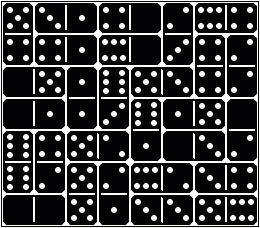
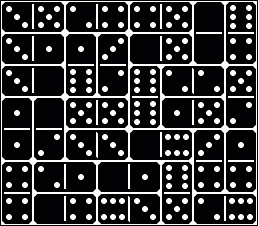
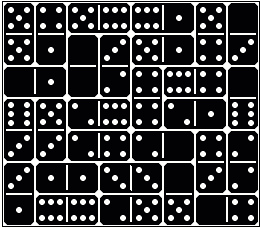

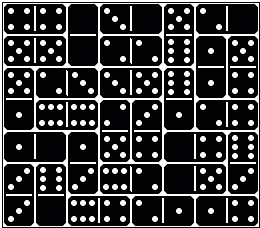
Bibliography
Adler, O.S., and Fritz Jahn -- Sperr-domino, oder das alte Dominospiel zu zweien, und Dominosa, neue Dominospiele zur selbstunterhaltung, 1921, Zülchow bei Stettin, 64 pp.Copyright ©2024 by Michael Keller. All rights reserved.
This booklet
was edited most recently on June 10, 2024.